22 Items in this Learning Collection
Collection Object
Collection Object
Collection Object
Collection Object
Collection Object
Collection Object
Collection Object
Collection Object
Collection Object
Collection Object
Collection Object
Collection Object
Collection Object
Collection Object
Collection Object
Collection Object
Collection Object
Collection Object
Copyright
All Rights Reserved
()
Suiten kyo (Sutra of Varuna, Deity of the Waters)
Accession Number
1964/2.104
Title
Suiten kyo (Sutra of Varuna, Deity of the Waters)
Artist(s)
Japanese
Artist Nationality
Japanese (culture or style)
Object Creation Date
circa 1300-1335
Medium & Support
handscroll, ink and color on paper
Dimensions
11 1/4 in x 81 1/8 in (28.6 cm x 206.1 cm)
Credit Line
Gift of Harold Phillip Stern, presented in memory of Archibald Gibson Wenley
Label copy
Suiten kyo ̄: Sutra of Varuna,
Deity of the Waters
Japan
Kamakura period (1185–1333)
to early Muromachi period
(1333–1573)
1300–35
Handscroll, ink and color on paper
Gift of Harold Phillip Stern, presented
in memory of Archibald Gibson Wenley,
1964/2.104
For centuries, chanting sutras (Buddhist scriptures)
have been an important part of Buddhist spiritual
practice. Sutras are studied and recited in order to
attain an understanding of the Buddhist way. They
are also copied or commissioned as an act of merit.
The central deity depicted in this sutra is Suiten, the
god of waters, who was associated with fishermen
and a variety of mythical water creatures. Here, Suiten
is astride a giant water dragon. The fierce deity on the
far left clasps a wheel of dharma (associated with the
Buddhist law, but also with the concept of fate) and
a sword for vanquishing evil. He also holds a brush
and scroll, characteristic of Ko ̄mokuten, one of the
Mantra Kings in esoteric Buddhism, known for their
wisdom and responsibility. Ko ̄mokuten represents
limitless vision and is commonly depicted with
serpents, like the ones writhing outwards from his
hair.
Subject matter
In esoteric Buddhism and other Buddhist sects, chanting sutras is an important part of spiritual practice. The central deity depicted in this sutra is Suiten, the god of waters known in Hindu as Varuna. In Japan, Suiten was associated not only with the sea, but also with fishermen and a variety of mythical water creatures, including dragons and snakes. Here, Suiten is astride a giant water dragon. The fierce deity on the far left clasps a wheel of dharma (associated with the law but also with the concept of fate) and a sword for vanquishing evil. He also holds a brush and scroll, characteristic of Komokuten, one of the Mantra Kings in esoteric Buddhism, known for their wisdom and responsibility. Komokuten represents limitless vision and is commonly depicted with nagas, or serpents like the ones writhing outwards from his hair.
Physical Description
This is a long horizontal scroll with several calligraphic inscriptions on the right portion of the paper. On the left are 3 figural scenes. The one closest to the writing shows a male figure wearing a large headdress seated in the lotus position within a circle. Next there is a figure with four arms who stands on the back of a dragon. Two people stand on either side- one a short blue-skinned man who holds a bowl and the other a smaller figure who holds a brush and paper. The third scene shows a male figure, seated in the lotus position, who holds a sword, a wheel, a brush and paper in his four hands.
Primary Object Classification
Painting
Primary Object Type
handscroll
Collection Area
Asian
Rights
If you are interested in using an image for a publication, please visit http://umma.umich.edu/request-image for more information and to fill out the online Image Rights and Reproductions Request Form.
Keywords
Buddhism
Figures
Japan
calligraphy
calligraphy (process)
dragon
dragons
figures (representations)
handscroll
handscrolls
1964/2.104
Title
Suiten kyo (Sutra of Varuna, Deity of the Waters)
Artist(s)
Japanese
Artist Nationality
Japanese (culture or style)
Object Creation Date
circa 1300-1335
Medium & Support
handscroll, ink and color on paper
Dimensions
11 1/4 in x 81 1/8 in (28.6 cm x 206.1 cm)
Credit Line
Gift of Harold Phillip Stern, presented in memory of Archibald Gibson Wenley
Label copy
Suiten kyo ̄: Sutra of Varuna,
Deity of the Waters
Japan
Kamakura period (1185–1333)
to early Muromachi period
(1333–1573)
1300–35
Handscroll, ink and color on paper
Gift of Harold Phillip Stern, presented
in memory of Archibald Gibson Wenley,
1964/2.104
For centuries, chanting sutras (Buddhist scriptures)
have been an important part of Buddhist spiritual
practice. Sutras are studied and recited in order to
attain an understanding of the Buddhist way. They
are also copied or commissioned as an act of merit.
The central deity depicted in this sutra is Suiten, the
god of waters, who was associated with fishermen
and a variety of mythical water creatures. Here, Suiten
is astride a giant water dragon. The fierce deity on the
far left clasps a wheel of dharma (associated with the
Buddhist law, but also with the concept of fate) and
a sword for vanquishing evil. He also holds a brush
and scroll, characteristic of Ko ̄mokuten, one of the
Mantra Kings in esoteric Buddhism, known for their
wisdom and responsibility. Ko ̄mokuten represents
limitless vision and is commonly depicted with
serpents, like the ones writhing outwards from his
hair.
Subject matter
In esoteric Buddhism and other Buddhist sects, chanting sutras is an important part of spiritual practice. The central deity depicted in this sutra is Suiten, the god of waters known in Hindu as Varuna. In Japan, Suiten was associated not only with the sea, but also with fishermen and a variety of mythical water creatures, including dragons and snakes. Here, Suiten is astride a giant water dragon. The fierce deity on the far left clasps a wheel of dharma (associated with the law but also with the concept of fate) and a sword for vanquishing evil. He also holds a brush and scroll, characteristic of Komokuten, one of the Mantra Kings in esoteric Buddhism, known for their wisdom and responsibility. Komokuten represents limitless vision and is commonly depicted with nagas, or serpents like the ones writhing outwards from his hair.
Physical Description
This is a long horizontal scroll with several calligraphic inscriptions on the right portion of the paper. On the left are 3 figural scenes. The one closest to the writing shows a male figure wearing a large headdress seated in the lotus position within a circle. Next there is a figure with four arms who stands on the back of a dragon. Two people stand on either side- one a short blue-skinned man who holds a bowl and the other a smaller figure who holds a brush and paper. The third scene shows a male figure, seated in the lotus position, who holds a sword, a wheel, a brush and paper in his four hands.
Primary Object Classification
Painting
Primary Object Type
handscroll
Collection Area
Asian
Rights
If you are interested in using an image for a publication, please visit http://umma.umich.edu/request-image for more information and to fill out the online Image Rights and Reproductions Request Form.
Keywords
Buddhism
Figures
Japan
calligraphy
calligraphy (process)
dragon
dragons
figures (representations)
handscroll
handscrolls
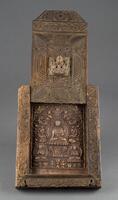

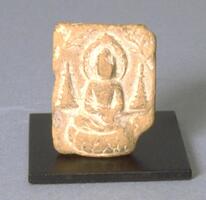

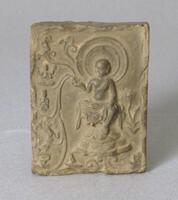
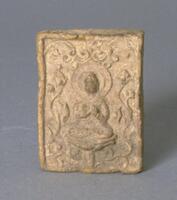
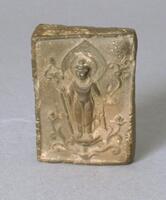


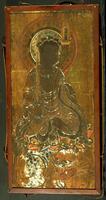
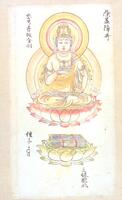
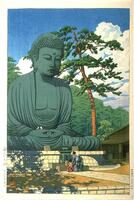
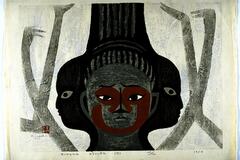
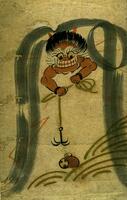


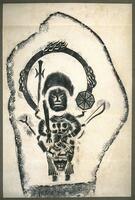






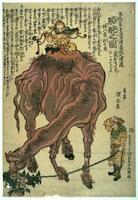

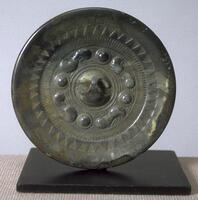
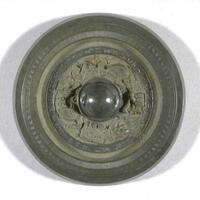




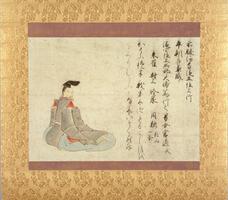

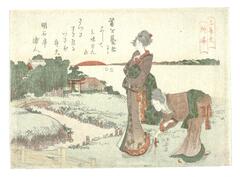
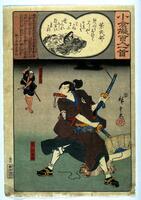



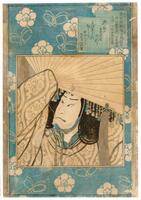
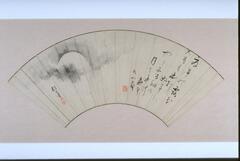

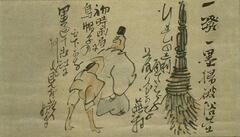

![In this monumental scroll, Nukina Kaioku has brushed a Chinese poem of his own composition, on the enduring theme of nature as refreshment for the spirit. Note his masterful variation of thick and thin strokes, wet and dry ink, stately and rapid movement.<br />The verses may be tentatively rendered into English as follows:<br /> Mandarin ducks enjoy the fresh water; their graceful forms glow as they pass through channels in the reeds.<br /> Pushing beyond the thickets [to the open pond], they call to one another again and again in the dawn.<br /> A crimson mist breaks through gaps in the glade, its glow warming hidden nests.<br /> Waking up with nothing to do, [I came here] to playfully row among the spring waves. In this monumental scroll, Nukina Kaioku has brushed a Chinese poem of his own composition, on the enduring theme of nature as refreshment for the spirit. Note his masterful variation of thick and thin strokes, wet and dry ink, stately and rapid movement.<br />The verses may be tentatively rendered into English as follows:<br /> Mandarin ducks enjoy the fresh water; their graceful forms glow as they pass through channels in the reeds.<br /> Pushing beyond the thickets [to the open pond], they call to one another again and again in the dawn.<br /> A crimson mist breaks through gaps in the glade, its glow warming hidden nests.<br /> Waking up with nothing to do, [I came here] to playfully row among the spring waves.](/media/W1siZiIsIjIwMjIvMDUvMjUvNDA4bXZmMmt5bF9kZWZhdWx0LmpwZyJdLFsicCIsInRodW1iIiwiMjQweDIwMCJdXQ?sha=1fda6bad9ec42b3f)


